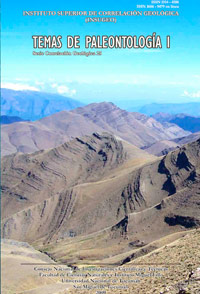Serie Correlación Geológica 25
Novedoso hallazgo de egagrópilas en el Mioceno tardío, Formación Andalhuala, provincia de Catamarca, Argentina
Graciela I. Esteban | Norma L. Nasif | Pablo E. Ortiz
Descargar trabajo en formato PDFResumen
NOVEDOSO HALLAZGO DE EGAGRÓPILAS EN EL MIOCENO TARDÍO, FORMACIÓN ANDALHUALA, PROVINCIA DE CATAMARCA, ARGENTINA.- Damos a conocer el hallazgo de dos egagrópilas fósiles procedentes de los afloramientos de la Formación Andalhuala (Mioceno tardío), valle de Santa María, provincia de Catamarca, Argentina. Las egagrópilas están formadas por numerosos huesos y dientes fósiles de microvertebrados, incluidos en una matriz arenosa. Interpretamos que estas estructuras fueron producidas por la actividad trófica de aves predadoras de talla chica, las “aves del terror” (Phorusrhacidae, Psilopterinae), que vivieron en el área durante el Mioceno tardío. Las egagrópilas tienen escala centimétrica, forma subovoide y contienen restos fragmentarios craneanos y postcraneanos bien preservados pertenecientes a roedores pequeños (Octodontidae y Cricetidae). Algunos huesos largos están casi completos (diáfisis con las epífisis), otros están articulados y otros están dispuestos irregularmente. Algunos dientes muestran un suave piqueteado que es una clara evidencia de corroción debida al proceso digestivo del predador. Este hallazgo constituye la evidencia física directa más antigua de egagrópilas fósiles en América del Sur y el registro más antiguo de un roedor cricétido en este continente.
Abstract
STRIKING RECORD OF PELLETS FROM THE LATE MIOCENE ANDALHUALA FORMATION, CATAMARCA PROVINCE, ARGENTINA.- We report the finding of two fossil bird pellets recovered from outcrops of Andalhuala Formation (Late Miocene), Santa María valley, Catamarca province, Argentina.The pellets are composed by several microvertebrate fossil bones and teeth included in a sandy matrix. We interpret that these structures were produced by the trophic activity of small predator, the “terror birds” (Phorusrhacidae, Psilopterinae), that lived in the area during the late Miocene. The pellets have centimetrical size scale, subovoid shape, and a highly calcareous matrix, and content highly concentrated and well preserved several cranial and postcranial fragmentary remains belonging to small rodents (Octodontidae and Cricetidae). Some long bones are nearly complete (diaphysis plus epiphyses), other bones are articulated and others are irregularly disposed. Some teeth show clear evidence of corrosion in enamel (pitting), due to digestive process of predators. This finding constitutes the oldest direct physic evidence of a bird pellet in South America and the oldest record of a cricetid rodent in this continent.






